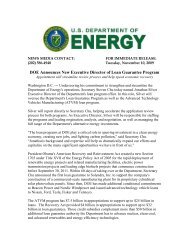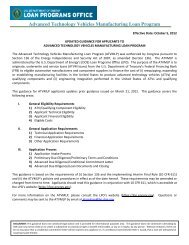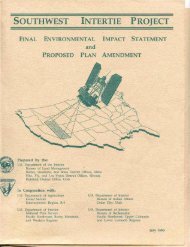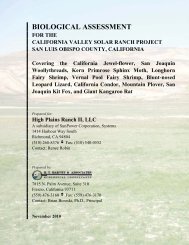Bureau of Land Management's Decision Record and Environmental
Bureau of Land Management's Decision Record and Environmental
Bureau of Land Management's Decision Record and Environmental
Create successful ePaper yourself
Turn your PDF publications into a flip-book with our unique Google optimized e-Paper software.
Jersey Valley Geothermal Development Project<br />
<strong>Environmental</strong> Assessment: NV063 -EAO8-09 1<br />
4 CUMULATIVE EFFECTS<br />
The CEQ regulations for implementing NEPA (40 CFR 1508.7) define cumulative impacts as:<br />
“. . . the impact on the environment which results from the incremental impact <strong>of</strong> the action when<br />
added to other past, present, or reasonably foreseeable future actions regardless <strong>of</strong> what agency<br />
(Federal or non-Federal) or person undertakes such actions. Cumulative impacts can result from<br />
individually minor but collectively significant actions taking place over a period <strong>of</strong> time.”<br />
4.1 CUMULATIVE EFFECTS STUDY AREA<br />
The cumulative effects study area (CESA) is the approximately 407,360 acre area which was<br />
determined on a hydrologic <strong>and</strong> topographical basis (see Figure 23).<br />
4.2. PAST AND PRESENT ACTIONS<br />
Past <strong>and</strong> present actions consist primarily <strong>of</strong> livestock grazing, recreational activities,<br />
transportation <strong>and</strong> access, wildfires, wild horse <strong>and</strong> burro use (including wild horse gathers),<br />
mineral exploration <strong>and</strong> geothermal exploration activities.<br />
Livestock grazing — Portions <strong>of</strong> seven BLM-managed grazing allotments are within the CESA:<br />
North Buffalo, South Buffalo, Jersey Valley, Home Station Gap, Pumpernickel, Copper Canyon,<br />
Cottonwood <strong>and</strong> Carico Lake (BLM, NV 2005). In order to support the management <strong>of</strong> these<br />
allotments, a variety <strong>of</strong> range improvement projects have been implemented through the years,<br />
including fences, cattleguards <strong>and</strong> wells.<br />
Recreational activities — Dispersed recreation occurs within the CESA <strong>and</strong> includes <strong>of</strong>f-highway<br />
vehicle (OHV) use, wildlife viewing <strong>and</strong> hunting.<br />
Transportation <strong>and</strong> access — Past <strong>and</strong> present actions within the CESA are supported by a<br />
transportation system which includes gravel County Roads, BLM Roads, <strong>and</strong> dirt roads or<br />
“two-tracks” on public l<strong>and</strong>s. Few are regularly maintained.<br />
Wildfires — Within the past decade there have been seven wildfires within the CESA: two<br />
unnamed fires (1999 <strong>and</strong> 2000), the Gooseberry Fire (2001), Smelser Pass Fire (2006),<br />
Cottonwood Fire (2006), the Buffalo Ranch Fire (2006) <strong>and</strong> the Horse Fire (2007) (BLM, MLFO<br />
2006a).<br />
Wild Horse <strong>and</strong> Burro Use — Portions <strong>of</strong> two BLM-managed Herd Management Areas (HMAs)<br />
are within the CESA: Tobin Range HMA <strong>and</strong> the Augusta Mountains HMA (BLM, NV 2007).<br />
Mineral exploration — Hundreds <strong>of</strong> active mining claims exist within the CESA.<br />
- 84 -







